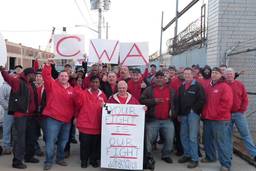WASHINGTON, D.C. — Last month, Secretary of Labor Hilda Solis tweeted: “As we explore every avenue to help our workforce recover, #volunteerism is a way job-seekers can do good and become more marketable.”
The pro-“#volunteerism” tweets were part of an effort by Solis to promote a new Department of Labor “Bridge to Work” demonstration program that allows up to 10 states to let companies employ workers receiving unemployment compensation without the employer necessarily having to pay those workers. Essentially, workers would be allowed to work without being paid in the hopes that the skills they gain would eventually lead to paying jobs.
With “Bridge to Work,” the Obama administration is effectively endorsing the growing trend of young people — e.g., fresh college graduates — having to work unpaid internships in their field of interest before landing a paid position. The Economic Policy Institute’s Ross Eisenbrey estimates that between 1 to 2 million people a year work as unpaid interns in the United States.
But critics say that with the new program, the Labor Department is going one step further by suggesting that if you are unemployed at any age, it’s a good idea to work for free to to help get a paid job. “Unpaid work and volunteerism should not be seen as “stepping stones” to a regular job: after all, today there are more unpaid internships around than ever before, and yet youth unemployment is near its all-time high,” says Ross Perlin, author of the book Intern Nation (which In These Times excerpted here). “Unpaid internships and “volunteer” situations (in cases where the person is really anything but) in fact tend to destroy jobs rather than create them, because firms learn that they don’t have to pay for work, they don’t have to hire.”
Some argue, though, that the new Department of Labor program could help people gain necessary skills needed in order to land a job. Studies of the Georgia Works program, on which “Bridge to Work” is based, didn’t show much evidence for this argument, however. According to Georgia Department of Labor data, 16.4 percent of those in the Georgia works training programs eventually got hired in jobs at the places they worked unpaid by the company. Census Bureau data reveals that 15 percent of all Georgians who were unemployed for six months or more found work within a month.
Also, a study by Eileen Applebaum of the Center for Economic and Policy Research showed that these “unpaid training jobs” actually gave workers few skills. 70 percent of the trainees hired after the end of the training program found employment in these or similar low-wage jobs, she noted. 60 percent of the jobs that Georgia Works participants acquired through the program were in four main low-skill categories – clerical, janitorial, restaurant work, and retail work. Over 80 percet of the jobs acquired by those in the Georgia Works program required a high-school diploma or less in order to gain them, according to a study by Mike Konczal of the Roosevelt Institute.
“NELP is very much opposed to the “Georgia Works”-ish programs that states have been trying to establish, both because we feel they often violate Unemployment Insurance and Fair Labor Standard Acts laws, but also because they are not effective ways to re-employ the long-term unemployed,” says Judy Conti of the National Employment Law Project (NELP).
“That being said, DOL’s guidance on the recent law allowing for up to 10 demonstration projects aimed at re-employment is very protective of workers — both their rights to be paid properly for taking part in these programs and to have reasonable expectations about the programs themselves, but also is protective of the current workforce to make sure employers do not use these types of pilot programs to displace and/or churn their current workforces. We really need to see how these projects will play out, but given the law that Congress passed, the Department of Labor seems to have issued very good guidelines and seems to be very attuned to the potential difficulties with these types of programs.”
The DOL program improves on the Georgia Work programs in that it forces companies to pay extra when an unpaid worker’s unemployment compensation benefits do not equal minimum wages or relevant prevailing wages laws.
But the program does not state that unpaid workers receiving unemployment compensation must be paid similar salaries to workers being paid for the same work in the same workplace. (Although the DOL program also does not allow companies to replace laid-off workers with unpaid workers receiving unemployment compensation.)
“The program still costs the employer nothing, as did Georgia Works, and requires no employer requirement that permanent jobs actually exist, so it is hard to understand why it won’t work in a similar manner to Georgia Works in terms of acting as a low-wage temp agency for the majority of unemployed participants,” Applebaum says. “One solution for employers to get around some of the requirements about not laying off current employees is to hire a subcontractor that employs people receiving unemployment benefits. These kinds of programs are going to function essentially like temp agencies while not providing people with chances of any real jobs.”
The increasing trend of having workers do work for free whether through unpaid internships or through the DOL program could hurt wages of employers over the long run. Already, union leaders in the construction industries are worried that the growing trend of unpaid internships could hurt paid apprenticeship programs that have long taught union construction workers skills while giving them a paycheck.
“Union apprenticeship programs have served as the lifeblood of the construction industry, injecting it with highly trained men and women who built lifelong careers that lifted workplace and industry standards for all industry participants — both union and nonunion alike” says Sheet Metal Workers International Association President Joseph J. Nigro.
“While it may be nobly intentioned, introducing unpaid internships into the construction industry will undermine the wages, working conditions and quality standards that workers and contractors have sought to maintain for decades. The funds that subsidize these internships are a taxpayer-funded bailout of unscrupulous employers who, history shows, will take advantage of these workers to undermine their competition and the industry.”

I hope you found this article important. Before you leave, I want to ask you to consider supporting our work with a donation. In These Times needs readers like you to help sustain our mission. We don’t depend on—or want—corporate advertising or deep-pocketed billionaires to fund our journalism. We’re supported by you, the reader, so we can focus on covering the issues that matter most to the progressive movement without fear or compromise.
Our work isn’t hidden behind a paywall because of people like you who support our journalism. We want to keep it that way. If you value the work we do and the movements we cover, please consider donating to In These Times.







